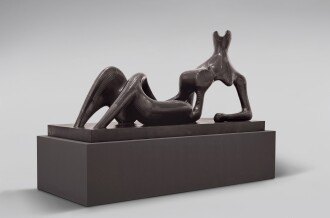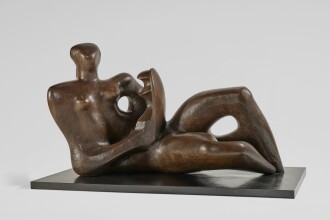Works by Henry Moore at Sotheby's
Henry Moore Biography
Henry Moore was a major British sculptor whose organically shaped, semiabstract, and often monumental bronze and stone figures made him one of the most important sculptors of the 20th century.
Born into a Yorkshire coal-mining family on July 30, 1898, Moore started training as a schoolteacher, until he was called to serve in World War I and was injured. Thanks to a rehabilitation grant in September 1919, he studied drawing and sculpture at the Leeds School of Art, from which he obtained a scholarship to study sculpture at the Royal College of Art in London. There, he spent time at the British Museum, discovering the power and beauty of Egyptian, Etruscan, pre-Columbian and African sculpture. Reacting against the European sculptural tradition, Moore moved away from the human figure to experiment with abstract shapes that made use of organic and natural forms – he studied bones, pebbles, and shells to understand what he called “nature’s principles of form and rhythm.”
From his first one-man exhibition and public commission in London in the late 1920s to his 1943 commission of a Madonna and Child for the church of St. Matthew in Northampton to his Reclining Figure, 1956–58, for the UNESCO building in Paris, Moore developed a distinct Modernist sculptural language that earned him international critical acclaim. After establishing the Henry Moore Foundation in 1977 and giving many sculptures from a 1978 exhibition of his work at London’s Serpentine Gallery to the Tate museum. His style, alongside fellow artists Barbara Hepworth and Ben Nicholson, would come to define British Modernist art.
Along with museums around the world, Moore’s work is in the collections of England’s Chatsworth House, Yorkshire Sculpture Park, Kew Gardens, and Fitzwilliam Museum. According to Sotheby’s Mei Moses index, the average compound annual return for Henry Moore resold at auction between 2003 and 2017 was 4.9%, and 84.3% of 172 such works increased in value.
Read Less











